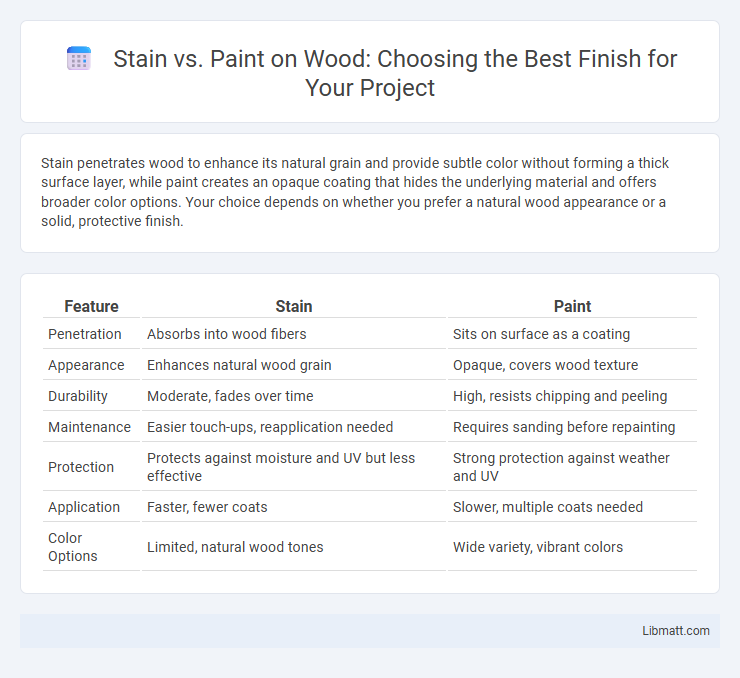Stain penetrates wood to enhance its natural grain and provide subtle color without forming a thick surface layer, while paint creates an opaque coating that hides the underlying material and offers broader color options. Your choice depends on whether you prefer a natural wood appearance or a solid, protective finish.
Table of Comparison
| Feature | Stain | Paint |
|---|---|---|
| Penetration | Absorbs into wood fibers | Sits on surface as a coating |
| Appearance | Enhances natural wood grain | Opaque, covers wood texture |
| Durability | Moderate, fades over time | High, resists chipping and peeling |
| Maintenance | Easier touch-ups, reapplication needed | Requires sanding before repainting |
| Protection | Protects against moisture and UV but less effective | Strong protection against weather and UV |
| Application | Faster, fewer coats | Slower, multiple coats needed |
| Color Options | Limited, natural wood tones | Wide variety, vibrant colors |
Understanding the Basics: What is Stain vs Paint?
Stain penetrates wood surfaces, enhancing natural grain and texture while providing protection, whereas paint forms a solid, opaque layer that covers the surface entirely. Stain allows moisture to escape, preventing wood damage, and is typically thinner with a translucent finish; paint offers a thicker coating that seals and hides imperfections but can trap moisture. Selecting between stain and paint involves considering factors like desired appearance, durability, wood type, and environmental conditions.
Composition and Ingredients: Stain Compared to Paint
Stain is primarily composed of pigments or dyes suspended in a solvent or oil base, allowing it to penetrate wood surfaces and highlight natural grain patterns. Paint consists of pigments, binders, solvents, and additives forming a thick, opaque layer that sits atop the surface for full coverage and color uniformity. Understanding these differences helps you choose between stain for enhancing wood texture or paint for durable, vibrant surface protection.
Appearance and Finish Differences
Stain penetrates wood to enhance its natural grain, providing a translucent finish that highlights texture and color variations. Paint creates an opaque layer that covers the surface completely, resulting in a uniform and smooth finish that hides imperfections. While stain maintains the wood's original appearance, paint offers a wider range of color options and a more solid, durable coating.
Application Processes: Staining vs Painting
Staining involves applying a pigmented or transparent liquid that penetrates wood fibers, enhancing natural grain patterns while providing protection. Painting requires applying an opaque layer of pigment that sits on the surface, offering a uniform color and stronger barrier against elements. Both processes require surface preparation, but staining typically demands less sanding and fewer coats compared to painting.
Surface Preparation Requirements
Stain requires thorough surface cleaning and sanding to enhance wood absorption and ensure even color penetration, often necessitating removal of old finishes or contaminants. Paint demands more extensive preparation, including priming to create a smooth, sealed surface that promotes adhesion and durability, and may require patching or sanding to eliminate imperfections. Both finishes benefit from dry, dust-free surfaces, but paint is less forgiving of surface irregularities compared to stain.
Durability and Longevity
Stain penetrates wood fibers, enhancing durability by providing protection against moisture, UV rays, and mildew while allowing the natural texture to show through. Paint forms a protective film on the surface, offering a more opaque finish that guards against weathering but can chip or peel over time, requiring frequent maintenance. Your choice between stain and paint depends on the desired lifespan and level of upkeep you're prepared to manage for long-lasting wood protection.
Maintenance and Upkeep
Stain requires less maintenance than paint because it penetrates wood fibers and resists peeling, chipping, and cracking while allowing the wood to breathe. Paint provides a thicker protective layer but is more prone to chipping, cracking, and fading over time, often necessitating frequent repainting and surface preparation. Proper maintenance for stain typically involves occasional cleaning and reapplication every 2-3 years, whereas painted surfaces may need touch-ups or full re-coating every 3-7 years depending on exposure and quality.
Cost Comparison: Stain vs Paint
Stain generally costs less upfront than paint, with average prices ranging from $15 to $30 per gallon compared to $20 to $50 per gallon for quality exterior paint. While paint provides a thicker, more opaque finish that usually requires more frequent maintenance, stain penetrates wood for longer-lasting protection and lower long-term expenses. Your choice between stain and paint should factor in initial cost, project size, and future maintenance budget.
Ideal Uses for Stains and Paints
Stains are ideal for highlighting natural wood grain and providing a protective, breathable finish suited for outdoor decks, fences, and siding where moisture resistance is crucial. Paints offer a durable, opaque coating perfect for interior walls, furniture, and exterior surfaces requiring vibrant colors and long-lasting protection against weather and wear. Choosing between stain and paint depends on the desired aesthetic, surface condition, and level of maintenance preferred.
Environmental Impact and Safety
Stain typically has a lower environmental impact than paint because it contains fewer volatile organic compounds (VOCs), reducing air pollution and health risks. Paint often includes higher levels of VOCs and chemical additives that contribute to indoor air quality issues and require careful handling and disposal. Choosing stain for your project can enhance safety by minimizing toxic exposure and environmental harm.
Stain vs paint Infographic

 libmatt.com
libmatt.com